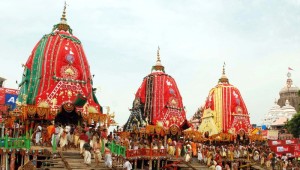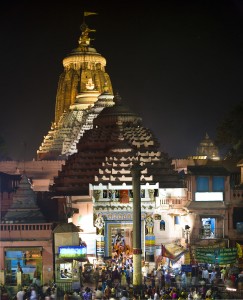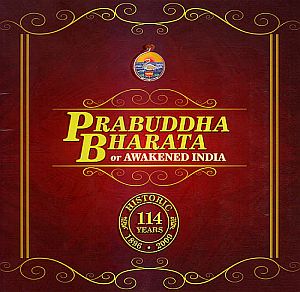
Puri Ratha Yatra
You cannot fully appreciate the words of Swami Vivekananda that in India, ‘it is religion that forms the very core of the national heart/ unless you visit the land that removes all sins (sarva-papahara-desa), according to the Kapila Samhita (2.2). It is the land that converts a Canda Asoka into a Dharma Asoka —Asoka the brute to Asoka the saint. I am referring to the great emperor Asoka, the King of Magadha, who converted to Buddhism after the famous Kalinga war. It is a land that culturally vanquishes its conquerors. Here, the ruler has to adopt the religion of the ruled so as to earn their obedience. Even Akbar the Great declared that this country is ‘no fit subject for conquest or for schemes of human ambition.’ Why is it so? This land ‘belongs to gods: from end to end, it is only a pilgrimage.’¹ This, then, is the land we are to speak about now—Orissa, the home of Puri, which in turn is the abode of Lord Jagannatha.
The Hajj of the Hindus Lord Jagannatha, the most humane and humanized god, is the life-breath of Orissa, and almost inseparable from the daily life of its deeply religious inhabitants. He is their friend, companion, helper in suffering, giver of boons, restorer of peace, and benefactor in every way. What is more, he is the giver of liberation—his sight is said to liberate the soul.’² In every disaster of Orissa, Jagannatha has borne his share. In every fight of the people against an invading power, he has been their comrade.
Most of the saints and saviours of humanity—Sankara, Nanak, Kabir, Ramanuja, Madhva, Caitanya, and a host of others [including, as some claim, Jesus Christ!]— have not missed to visit Puri, the spiritual metropolis of India. All of them, specially Sri Caitanya, have left an indelible imprint on the temple system. We can include the Buddhists too in this list, as they consider Jagannatha as the Buddha. Indrabhuti of the 4th century CE described Lord Jagannatha in his Jhanasiddhi (1.1) as follows: ‘Pranipatya jagannatham sarva-jina-vararcitam; sarva-buddha-mayam siddhi-vyapinam gaganopamam’. I salute Jagannatha, who is adored by all the great monks. He is vast as the sky and is an embodiment of all the Buddhas.’ The pantheism of Jagannatha has accepted all and rejected none.
Sri Ramakrishna used to prescribe Jagannatha’s mahaprasada as of utmost importance for seekers of God. What is this mahaprasada? It is the sanctified rice, offered to Lord Jagannatha, which never gets sullied. Even a brahmin accepts it from a low-caste person. There is no question at all of this sacred rice being defiled. This rice is dried, kept in containers for days, and a particle of it is eaten daily so that the body, mind and soul of a person is instantly purified. It is called nirmalya or mahaprasada. This rice is considered the most sacred food. Sri Ramakrishna had great love for Lord Jagannatha. He has said that his body would have fallen off had he visited Puri. But he never missed a chance to pull the chariot of the Lord at Balaram Bose’s house in Calcutta. He once broke his arm while trying to embrace the Lord in ecstasy.
The famous saying in Sanskrit (from a Samhita), ‘Rathe ca vamanaih drstva yunar- janma na vidyate’ tells the glory of Jagannatha unequivocally: ‘By seeing the Lord on the chariot one is freed from rebirths.’ There is one more saying in the Nilamani which means that to envision the Lord as seated on his chariot called Nandighosa is to envision the veritable Narayana himself. This is the firm belief of the Hindus, and for ages now, Jagannatha is attracting devotees from distant places. Visiting Puri is the goal of life, a duty of utmost concern for the devout Hindu. It is like the Hajj pilgrimage for the Muslim. Times have changed recently, and there are better facilities of travel now. But imagine the earlier period! Extreme hardship, endless suffering, constant fear of being looted and killed on the way, the terror of wild animals—undaunted by all these trivialities, devotees flocked the holy city of Puri year after year, specially during the famous Car Festival (Ratha Yatra). The Car Festival is held on the second day of the bright fortnight in Asadha (June-July) every year.
The Story Behind

Puri Jagannath
What is this Car Festival, which draws millions—big and small—from everywhere in India and abroad every year? During the last century, this festival was famous in the western world in a negative sense: the Juggernaut was used to ridicule Hindu religion. Not a little has been spoken against the Lord of Puri by self-seekers. With all that, pilgrims are thronging for a sight of the Lord. What is the idea behind all this?
The legend part of it is this: Lord Jagannatha, along with his elder brother Balabhadra and sister Devi Subhadra—all riding on separate chariots—visit Gundica Ghara, the house of Gundica, situated about three and half kilometres away to the north-west of the Jagannatha temple. Who is Gundica? Why is Jagannatha so intimately associated with her that it makes him visit her house each year, as if committed to do so? According to a tradition, Gundica was the queen of the great altruist king Indradyumna, who, after building the Jagannatha temple, asked the Lord to destroy his family so that none can claim to be the owner of the temple. In fact, Gundica was responsible for having the images of the holy trinity (Jagannatha, Subhadra, and Balabhadra) half-constructed as worshipped in the temple today. According to the legend, when all the earthly carpenters failed, the celestial carpenter Visvakarma came in the guise of an old man and undertook the job of carving the images out of the mysterious log which was received for the purpose. The condition set by him was this: he would take twenty-one days to complete the carving of the images. But it would be done inside the sanctum, behind closed doors, during which period he would not touch food or water. A few days later, as destiny was to be, the sound of chisel and hammer could no longer be heard any more from inside the sanctum. Perturbed at this strange silence, scared that the old man inside might have lost his life due to starvation, the queen ordered the door opened, thus breaking the contract. There the images were half-ready, but the old man had vanished. A divine command was heard: ‘God will be worshipped in this form during the present age.’
According to the Oriya work Sarala Mahabharata³ (Musali Parva), Gundica was the wife of a tribal named Jara. It was she who actually carved the images out of the holy log. She was worshipping the Lord with great love and devotion.
Whoever Gundica might be, either the wife of King Indradyumna or the tribal Jara, her house was the place where the images were made. Therefore, the Car Festival or the sojourn of the Lord to Gundica House is considered to be the Lord’s ‘homecoming’ to have a free chat with his own kinsmen, away from the busy schedule and a life of formalities at his ‘office’, i.e. the temple.
The Car Festival
Conches blow, trumpets blare forth, gongs sound and cymbals chime, the sound of the joyous cries of people rent the air, the sky above is filled with the ululations of women, millions of pairs of hands are raised above in a gesture of self-surrender, the ocean of humanity tosses itself into waves—up and down, to and fro—singing and dancing in ecstasy—the heavens above and the earth below seem to be thrilled in the bliss of the spiritual vibrations created when Lord Jagannatha ascends His chariot. And the virtual temple of the Lord rolls on along the grand avenue of Puri.
Three wooden chariots are made every year: the making itself begins on aksaya tritiya. Each chariot comprises thirty-four components. The side deities, the charioteer, horses, pitcher, etc. are not renewed every year. Nandighosa, the chariot of Lord Jagannatha, is a 13½-metre-high pyramidical structure supported by sixteen wooden wheels and covered by red and yellow cloth. It has got nine subsidiary deities, four horses, and a semi-circular pathway (parikrama) around the sanctum which looks like a temple. Taladhvaja, the chariot of Balabhadra, is decorated in red and green cloth and Devadalana, the chariot of Devi Subhadra, is decorated with red and black cloth. The other two chariots resemble Nandighosa, though they are a bit smaller in size and are supported by fourteen and twelve wheels respectively.
The process of the Car Festival begins with the festival of snana yatra, the bathing festival of Jagannatha, and ends with the re-installation of the deities on the golden throne of the main temple after the return car festival (bahuda yatra). For fear of increasing the length of my article, I am not going into all the details of the beautiful ceremonies.
The uniqueness of this cycle of celebrations is the switching over of all worship rights of the Lord from the brahmin priests to the priests of an aboriginal community, called daityapatis. The brahmin priests perform peripheral activities till they get back to the centre-stage only after the re-installation of the deities in the main temple following the completion of this cycle of celebrations that takes about a month’s time.
The bathing festival takes place on the full-moon day of the month of Jyestha, when each of the deities, Jagannatha, Balabhadra, and Subhadra, is bathed with 108 pitchers of water. Apparently, though it is seen by the devotee as the Lord’s indulgence in water- sport in order to ward off the excessive summer heat, symbolically, it is the washing off of the brahminical traits acquired by the Lord.
Then the deities are taken to anasara tati, a thatched construction inside the temple. To the loving devotee, it means that the Lord has fallen sick owing to prolonged indulgence in water. The brahmin priests are not even allowed to see the Lord inside the anasara tati. The diet of the deities change to the aborigines’’ prescription. They have to undergo treatment and also have to put up elaborate make-up for the forthcoming festival. The physicians of the gods are the daityapatis. This is followed by the netra utsava and nava youvana darsana, ie, seeing the Lord in his renewed youth, which takes place on the eighth day, called rekha astami.
It is now the most lonesome period for the 192-foot-high Jagannatha temple (built in the 12th century) and the 20-foot-high Meghanada wall that encloses about 4,10,000 sq. feet of the temple complex. The whole complex appears desolate as the Lord gets ready to move into the ‘virtual temple’, wait¬ing outside the campus for Him.
First of all, the weapon of the Lord (Sudarsana), makes his way to the chariot of Subhadra, the Devadalana. Then Balabhadra, who is fair in complexion, representing the white people of the western world, moves into his chariot, the Taladhvaja. Soon, Subhadra Devi, who by her yellow colour symbolizes the ‘yellow’ people like those of China, Japan, Korea, etc. enters her chariot. Finally, Jagannatha, the black-god, symbolizing the swarthy races all over the globe including Indians, comes out. The Lord, bereft of hands and feet (apanipadam), watching the eternal flux endlessly with his lid-less sun-like eyes, rides the Nandighosa in the picturesque Pahandi—an art component of Odissi dance.
Before the climax of the festival is approached, which is the pulling of the chariots, one more event takes place. It is called the cera pahanra—the formal act of ‘sweeping’ of the chariots. The titular king of Puri, the first and foremost servitor of Lord Jagannatha, finds himself fortunate to do the job as per the age-old tradition. Once this sweeping of the chariots is over, the cara or impromptu stairs of the chariots are removed, respective ‘horses’ fixed to all the chariots and four huge ropes tied to each of the three chariots, making them ready to move on.
Tracing the historicity of the Ratha Yatra of Lord Jagannatha is a bit difficult. According to the temple chronicle in palm leaves (madala panji), the Car Festival was discontinued several times during the Mohammedan invasion during the 4th century and other foreign suppressive activities in Puri. The earliest literary evidence of the Car Festival synchronizes with the rule of the Soma dynasty during the 2nd century BCE. A 10th century drama also speaks of the Car Festival. The oldest iconographical evidence of the festival belongs to the period of the Ganga dynasty (13-14 century CE).
Whatever historical evidence might have been lost to us, Lord Jagannatha continues to be the centre around whom the integrity, culture, spiritual life, socio-economic life of Orissa, and also of India to a great extent, revolves even today. The Jagannatha Car Festival remains one of the most important religious festivals of India and its attraction seems only to grow with time.
The Car Festival is a perfect custom which helps universal harmony as it makes all faiths come closer physically, psychologically and culturally. The virtual temple of Lord Jagannatha performs the excellent job of human equality in reality, not superficially. In the words of W.W.Hunter,’…the true source of Jagannatha’s undying hold upon the Hindu race consists in the fact that he is the god of the people. As long as his towers rise upon the Puri sands, so long there will be in India a perpetual and visible protest of [sic] equality of man before God.’4
References:
- Quoted from Stirling, Asiatic Research, XV, pp. 167, 291.
- A History of Orissa, ed. N.K. Sahu (Delhi: Bharatiya Publishing House, 1980), Vol. 1, p. 5.
- A great saint of Orissa belonging to a low caste and respected by all as ‘sudramuni’, who composed the Mahabharata in Oriya.
- History of Orissa, p. 6.
Photo Attribution: By Zephyrmaten (Own work) [CC BY-SA 3.0], via Wikimedia Commons
